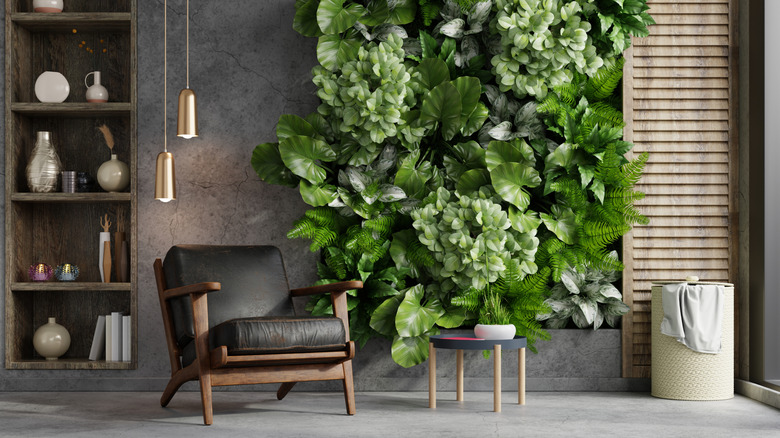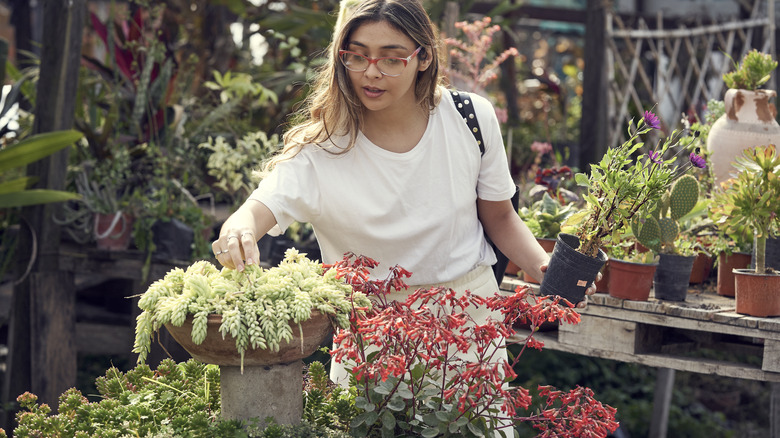Make A Charming DIY Arched Plant Wall With Affordable Materials
We may receive a commission on purchases made from links.
You've spent hours, days even, picking through selections from your favorite green-thumbed influencers and HGTV gardening stars to create a collection of colorful houseplants that will perk up your indoor space. The trouble is, you have nowhere to showcase the plants once you purchase them. If you're even the teeniest bit handy, get yourself a bunch of wall-mountable metal plant pot rings, cut an arch shape from a piece of cheap plywood, pop in some plants, and voila! You have a cheap but cheerful plant wall. Bonus: It couldn't be easier to switch out plants based on the seasons or your personal preference of the moment.
The standard residential ceiling height in the U.S. is 9 feet, so getting a sheet of wood a little under that height should work fine for most homes. For example, a 4 x 8 foot, 1/42" thick Sauers Red Oak Flat Cut Veneer Sheet costs about $90. If you have a historic home or are putting the plant wall up in a quirky space, measure the spot first to ensure you get the right size sheet. And remember, you'll cut two of the corners off to create your arch shape. A set of 10 Taicheut 6 Inch Black Metal Plant Pot Ring Holders will set you back just $28 and should offer enough design flexibility for a single arch. Pick up, too, an 8 pack of T4U 6 Inch Plastic Planters with Drainage Holes and Saucer for about $20 and some potting medium designed for indoor use.
The how to: making your DIY arched plant wall
Supplies gathered, you're ready to put together this no-fuss way to hack a beautiful living wall. Measure and mark the arch curve on one end of your wood sheet using a carpenter's pencil and cut it out using a bandsaw (the flat table helps keep things accurate) or a jigsaw. Unless you've purchased marine-grade plywood, raw timber sheets are particularly moisture-resistant — if they are at all. And that's a problem for a wall-mounted arch designed to hold thirsty plants. To stop the wood from getting wet, you'll need to finish it.
It might seem counterintuitive, but exterior paint provides ultimate waterproof-ness. Choose a hue that matches or contrasts with your existing interior palette, or go for something neutral to ensure the plants remain the stars of the show. If you want to retain the raw wood look, try a transparent oil-based varnish like this quart bucket of Rust-Oleum 207008 Marine Spar Varnish in Gloss Clear for about $20.
Mount the arch to your wall using a wood glue like Liquid Nails Heavy Duty Construction Adhesive at a bit under $4 for a 10 oz tube and a nail gun. Once the arch is secured to the wall, use a carpenter's pencil to mark where you want the rings to go. Use a ruler to measure the spots for a geometrically precise arrangement or just eyeball it for a more organic approach. Attach the rings using a power drill and screws — they're typically provided with the product.
Indoor plant arch alternatives to try and what to grow
If you really love plants, stack multiple arches full of greenery side by side or stagger them along a particularly long wall, leaving space in between to give an Ancient Roman villa courtyard vibe. You don't have to limit yourself to an arch, either. If you have the tools, get creative with your shapes — straighten the arch so it has three sides and extra corners, or cut out a geometric parallelogram with angles on both ends. Don't have a power drill? Swap out the wood sheet for classic timber pegboard where your plant pots sit on wooden shelves supported by pegs.
Once you have your board mounted, whatever its final construction, you'll need to dress it with greenery. Determining the best plants to use to create a stunning living wall indoors is partly based on what you like to look at and a lot based on the location of your arch and the species of plants that thrive inside rather than out. For example, trailing pothos thrive in most light levels and offer vibrant leaf hues, peace lilies bring long-lasting and colorful blooms, and parlor palms provide some dramatic texture. Pot your plants up as soon as they arrive at your home for best health. Care is similar to ordinary potted plants, though it's a good idea to remove the pots from their holders and water the plants in your kitchen sink to avoid water drips on your floor. You can also mist plants if they look lackluster without fear of ruining your interiors.

